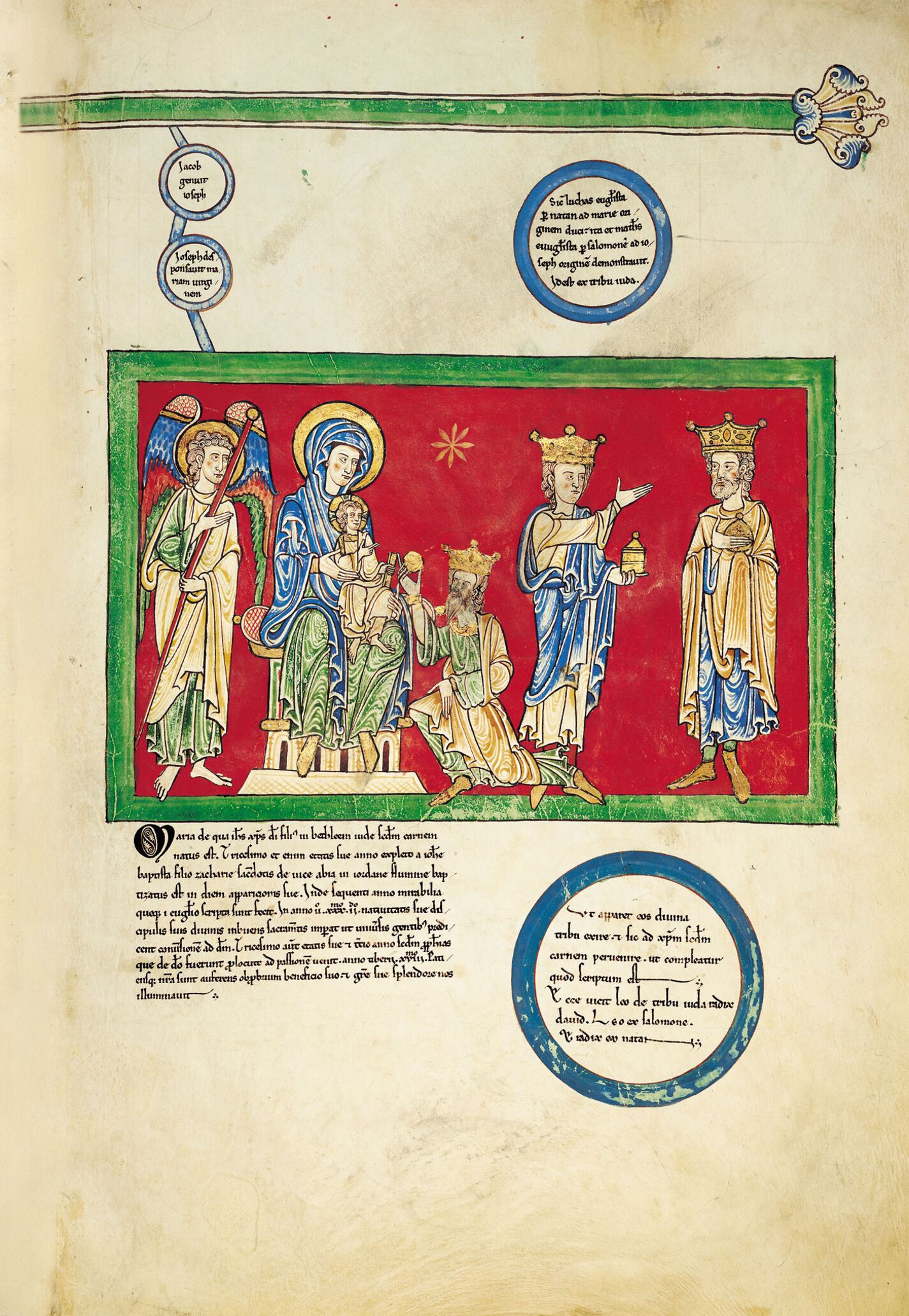The exultation of the incarnation of Christ is one subject featured in branch IIa and IIb Beatus codices. But the miniature and the text, and likewise the eagle and the serpent associated with it, have nothing to do with the Commentary on the Apocalypse. The Virgin is increasingly prominent due to the Incarnation (December 18th) and the Epiphany. The Antiphonary of Léon dedicates seven masses to the Incarnation (the same as for Christmas) and eight to the Epiphany. The illustration in the Cardeña Beatus complies with established canons, although certain conventions are adapted to make them more intelligible. The Annunciation in the Léon Bible I and the first part of branch IIa codices depicting the birth of the Child, becomes a double scene portraying the Angel Gabriel with the Virgin and Child in the scene of the adoration of the Magi, with the first part portraying the Annunciation. This scene, which is apparently not clear in the Facundus Beatus, is clearly depicted in the Gerona Beatus which stemmed from our codex. The adoration of the Magi is interesting because of its dogmatic and symbolic considerations in connection with the purpose of the Genealogies in which Christ is portrayed as a sign of salvation via Mary. The image in Bible I mentioned earlier indicates the kingdom of Léon as its place of origin, whilst the proto-Gothic relief preserved in the cathedral with the Virgin and the naked Child at her breast indicates its extended life-span.
The landscape miniature in the centre of the folio in the Cardeña Beatus illustrates the text and complements the genealogies, based upon the images in the last two circles.
The illustration is explained by the text (riddled with grammar mistakes), Maria de qua Iesus Christus in bethlem iude secundum carnem/ natus est. Et vicesimo et enim etatis sue anno expleto a iohanne/ baptista filio zacharie sacerdotis de uice abia in iordane flumine bap/tizatus est in diem apparicionis sue. Indesequenti anno mirabilia/ queque in euangelio scripta sunt fecit. In anno quinto trigesimo secundo natiuitatis sue dis/cipulis suis diuinis inbuens sacramentis imperat tu uniuersis gentibus predi/cent commisione ad dominum. Tricesimo autem etatis sue et terctio anno secundum protas/que de deo fuerunt perlocute ad passionem uenit. Anno tiberii decimo octauo. Patiens/que nostra sunt auferens obprobrium beneficio suo et gracie sue splendore nos/ illuminati. A larger circle on the right contains the following text, which assimilates Christ with the lion of the tribe of Judah, Tu apperet eso diuina/ tribu exire et sic ad christum secundum/ carnem peruenire. Tu compleatur quod scriptum est/ Ecce uicit leo de tribu iuda radix/ dauid. Leo ex salomone. Ex radix est nata.
The Annunciation/Epiphany is one of Master A most successful illustrations. It has a green frame and consists of six figures highlighted by a dark red ground. The Angel Gabriel stands with the staff, looking at Mary seated on the throne with the Child on her lap. He is about to receive the gift of the first king, Melchior, on bended knee, whilst Caspar and Balthazar stand talking. This is undoubtedly a forerunner of Gothic style work. The first group is shifted to the left with the star of Bethlehem and king Melchior acting as an axis of symmetry. Balthazar and Melchior have beards, whilst Caspar is beardless, as in Gothic art. We are far removed from the Gerona Beatus and its Epiphany scene with the same number of figures identified by means of the corresponding signs, reading from left to right: Gabriel, María, Cristo, Melcior, Tagasma, Altasara, aurum, thus and mirra. The kings arrive in a procession wearing Phrygian caps, which have been replaced in the Cardeña Beatus by the elegant jewelled crowns typical of western monarchs, hose and short tunics, and one with a belted cloak.
Ángela Franco Mata
Chief of the Medieval Antiquities Department, Museo Arqueológico Nacional
(Fragment of the Cardeña Beatus commentary volume)
